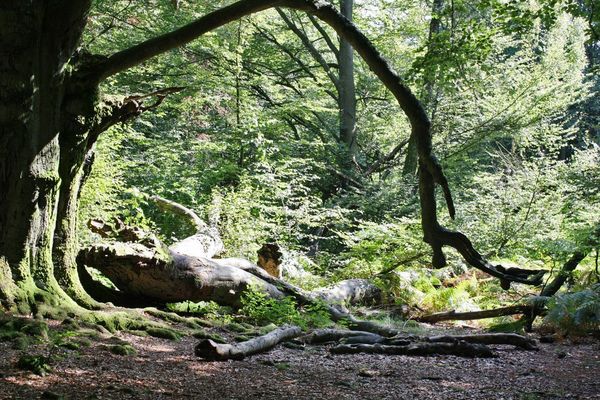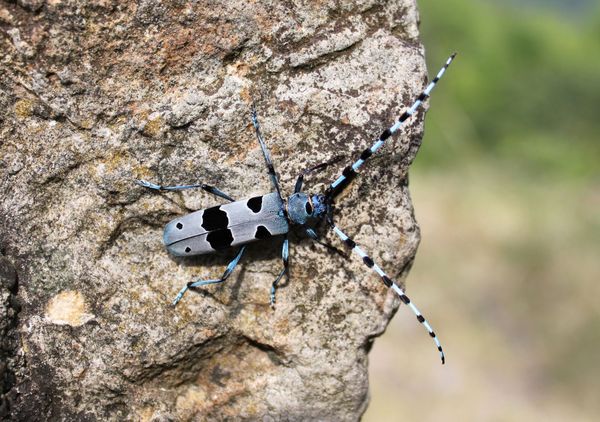Expertise
Logging ban for old, near-natural beech forests
Andreas Bolte | 08.12.2022
The coalition agreement of the current federal government provides for a stop of logging in old, near-natural beech forests in public ownership. This is intended as a contribution to both climate protection and biodiversity conservation. Depending on the definition, old, near-natural beech forests occur on approx. 1 - 3% of the forest area in Germany. What can we expect from the measure for climate protection and nature conservation?
The common beech (Fagus sylvatica) is a typical tree of Central Europe. By nature, 75% of Germany's forest area would be covered by beech forests. Following overexploitation of the forests from the Middle Ages until the 19th century, many beech forests were replaced by coniferous forests mostly with spruce or pine for economic and practical reasons. According to the last German National Forest Inventory (Bundeswaldinventur) 2012, beech is currently predominant on 16.6% of the forest area (approx. 1.8 million ha). In the public forests, beech dominate on just under 1.2 million ha. These forests are predominantly owned by cities and municipalities as well as by the Länder; significantly less is federal forest.
Old, near-natural beech forests: how to define?
A "logging ban" means a complete renunciation of tree cutting for an unlimited time. It is therefore important to first define what type of beech forests are affected. The definition proposed by the Thünen Institute comprises four criteria:
- Beech forests with at least 75% beech share of the basal area cover the requirements of near-natural beech forests well; lower shares bear the risk of including mixed forests with coniferous tree shares that are far from natural, so-called semi-forests.
- "Old" beech forests should have a minimum age of 140 years, because by this time the zenith of valuable timber production has already been reached. The economic loss due to non-utilisation is therefore lower beyond this age than in younger stands.
- Since beech forests represent the majority of recent natural vegetation in Germany, all beech forests occurring today (with > 75% beech content) are to be classified as near-natural.
- A minimum size of 1 ha of forest area allows for a forest interior climate typical of beech forests, which contributes to the development of a characteristic beech forest flora.
Applying these criteria results in an area of 113,000 ha of old, near-natural beech forests in public ownership (approx. 1% forest share). For comparison: If the age limit is lowered to 120 years, the minimum proportion of beech to 50% and the 1 ha minimum area is waived, the total area increases to approx. 365,000 ha of area in public forest (approx. 3% forest share). High proportions of old, near-natural beech forests are found in Hesse, Rhineland-Palatinate and Baden-Wuerttemberg.
Impact of the logging ban on climate and nature conservation
By stopping logging in 120- and 140-year-old near-natural beech forests, the biomass carbon pool can currently be increased by estimated 3.8 and 1.9 Mt CO2 (on average 2.7 Mt CO2) annually. This corresponds to 0.3 to 0.6% of German greenhouse gas emissions in 2021 (675 Mt CO2). This does not take into account the lost substitution effects of the unused wood when replacing energy-intensive materials such as concrete, steel or bricks or fossil fuels with wood from these forests. This additionally reduces the climate protection performance of the logging ban. The share of areas prone to climate change risk should also not be neglected. Almost 40% of the 113,000 ha of old, near-natural beech forests available grow on dry or very dry soils. As a result, there is a significantly increased risk of dieback, which endangers the preservation or the targeted increase in carbon stocks.
The main impact of the logging ban is therefore likely to be for the protection and development of the typical biodiversity in old beech forests. Especially during the transition to the decay phase, special structures such as broken branches, tree hollows and old trees as well as standing and lying deadwood develop undisturbed. The beech forests thus provide additional habitat for rare insects that live in deadwood, such as the lesser stag beetle (Dorcus parallelipipedus) or the alpine longhorn beetle (Rosalia alpina), and fungi such as the coral tooth fungus (Hericium coralloides). If the areas are then included in a network of existing protected areas or in a biotope network system , this enables the mobility of rare forest-dwelling species.
Conclusion
A logging ban in old, near-natural beech forests in public ownership has only a limited effect on climate protection because the contemplable manageable forest areas provide only small additional CO2 sequestration capacities, and under considerable risks. Furthermore, drought-prone beech forests cannot be actively converted into adaptable forests if no further intervention is allowed.
With regard to biodiversity, however, these areas can achieve a high level of significance by making an important contribution to the protection of old-growth and deadwood-bound insect, plant and fungus species, especially if they are well connected. Connected biotopes provide dispersal opportunities for rare species and thus contribute to their conservation.








